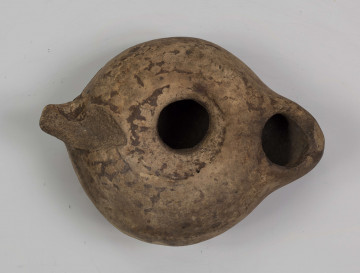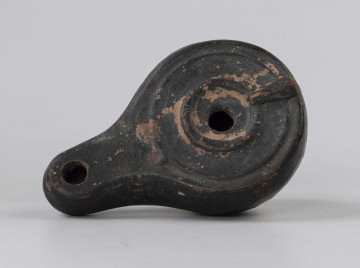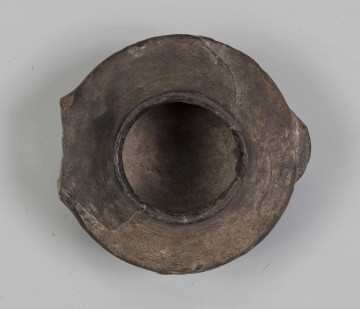
Oil lamp
201 — 400
National Museum in Lublin
Part of the collection: Archaeological monuments of the Lublin region
Presented oil lamp is only one of the few owned by the National Museum in Lublin. Unfortunately, we do not have detailed information on how it was obtained.
Oil lamps have been used for thousands of years. They were already used in Mesopotamia, Egypt, and by the ancient civilizations of Greece and Rome. However, based on analogous finds, we can say that the lamp we are describing comes from the second half of the 1st century CE and was made in the Roman Empire.
How did such a lamp work?
As we can see, the vessel consists of a bowl with a spout and a handle. In the central part there is a hole through which flammable oil was poured - in this case, olive oil (owning to the concave structure of this part, the oil could easily drain into it). The lamp's spout also had an opening through which a wick dipped in the oil protruded. A wick soaked in oil could be set on fire. Of course, the handle was used to hold the lamp or carry it safely. To get more light, some of the oil lamps could also be hung from the ceiling.
Interestingly, in Poland such oil lamps were also called a torch. To this day, the expression "Carry the torch of education” referring to raising the level of people's education is in use. It originates from the fact that the torch, i.e. the oil lamp, made it possible to work and learn also after dark.
Author / creator
Dimensions
cały obiekt: height: 11,7 cm, diameter: 7,2 cm
Object type
tool
Technique
firing
Material
clay
Creation time / dating
Creation / finding place
Owner
The National Museum in Lublin
Identification number
Location / status

201 — 400
National Museum in Lublin

250 — 300
National Museum in Lublin

201 — 500
National Museum in Lublin
DISCOVER this TOPIC
National Museum in Lublin
DISCOVER this PATH
Educational path